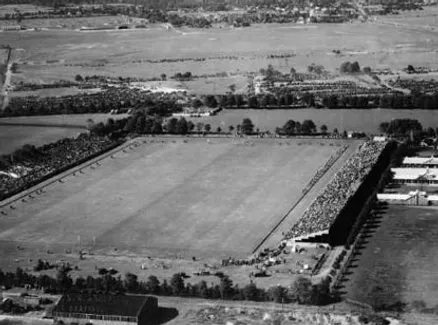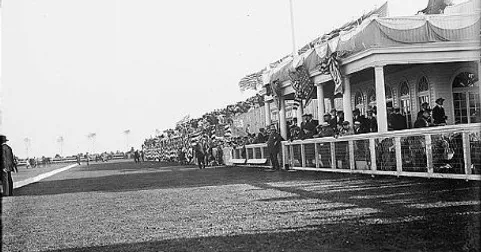Club History
The history of Long Island polo is indeed a fascinating one. It began in 1879 when several members of the Meadowbrook (original spelling was Meadow Brook ) Polo Club including Thomas Hitchcock, Sr., Oliver W. Bird, August Belmont and Benjamin Nicoll started to play the game in the infield of the racetrack of the Mineola Fair Grounds.
The Club was formerly incorporated in 1881 and the first “official” polo field was built in 1884. From these somewhat simple origins Meadowbrook in time emerged not only as the doyen of Long Island polo clubs but also the citadel of international polo.
Clearly, the most important national event was the annual Open which was held at Meadowbrook from 1923 until 1953. Powerhouse teams such as Meadowbrook, Great Neck, the Hurricanes, Templeton, Greentree and Old West bury thundered across the fields with such legendary riders as Tommy Hitchcock, Michael Phipps, Stewart Iglehart, Laddie Sanford, J. Watson Webb, Devereux Milburn and Winston Guest.


In this “Golden Age of Polo” the sport was a popular pastime as well. The crowds were especially large for the major events such as the national Open and the international matches.
For the 1926 Open, over 30,000 fans came to see Laddie Stanford’s Hurricanes against Argentina. And the Westchester Cup matches (United States vs. England) of 1924, 1927 and 1930 drew as many as 45,000 spectators while the three-game 1928 Cup of the Americas, (United States vs. Argentina), drew over 100,000 people, including an astounding 25,000 for a Tuesday match.
The excitement of a major polo match was vividly captured by writer Damon Runyon, who attended one of the 1930 Westchester Cup games:
“Though the game didn’t start until 4pm, the Long Island roads leading to Meadow Brook were clogged with traffic from early afternoon. Thousands of motorists used the parkway, which you can travel at the cost of a dollar and go as far as you please. Special trains on the Long Island Railroad unloaded packed cars at the gates of Meadowbrook where the mob of hustlers and souvenir vendors that follow every big Eastern sporting event were kicking up the dust. Acres of automobiles were parked in the area, some as far as a mile from the field.
“As early as 1 pm, there were little picnic parties spread out on the grass behind the stands, munching hard-boiled eggs, ham sandwiches and what-not. Chiefly, what-not…
“There was a grand entrance before the game, just like a circus. The ponies were led past the stands, all saddled and bridled, their legs swathed in bandages…
“The Panama hat and white flannel trousers survived among the males, although it is September, and a lot of the gals clung to their sports clothes.”
This linkage of fashion with polo has been one of the sports most enduring themes. The game itself made its own contributions to the world of fashion with such innovations as the “button down shirt” (designed to prevent collars from flapping while playing), the camel hair “polo coat” and the ubiquitous “polo shirt”.
Regretfully, World War II brought top-flight polo at Meadowbrook to an abrupt end. After a brief recovery, the original Meadowbrook Club in 1954 became a casualty of the building of the Meadowbrook Parkway and postwar suburbanization.

The club relocated to a smaller facility in Jericho and then, in 1968, the fields were again sold for development. The Meadowbrook polo players established a new “Meadowbrook Polo Club”, as it is today, in Old Westbury.

Over the last couple of decades, the amount and quality of play has steadily progressed, attracting an ever increasing number of players (including a steadily growing contingent of women) and spectators.
Much of the credit for the initial revitalization of Meadowbrook was owed to Al Bianco, the then club chairman, his wife Barbara and to the late Peter Henderson, Sr. Their involvement, along with those of scores of supporters, culminated in the United States Polo Association awarding the club the prestigious Open Championship in 1994 and 1995.
These two Opens were among the finest played in the post-war years and the 1994 final match arguably ranks as the most memorable and exciting ever.
Al Bianco pass the reins of the club to Bryan Lazarus and Luis Rinaldini who’s ceaseless efforts continued the tradition of polo at Meadowbrook.